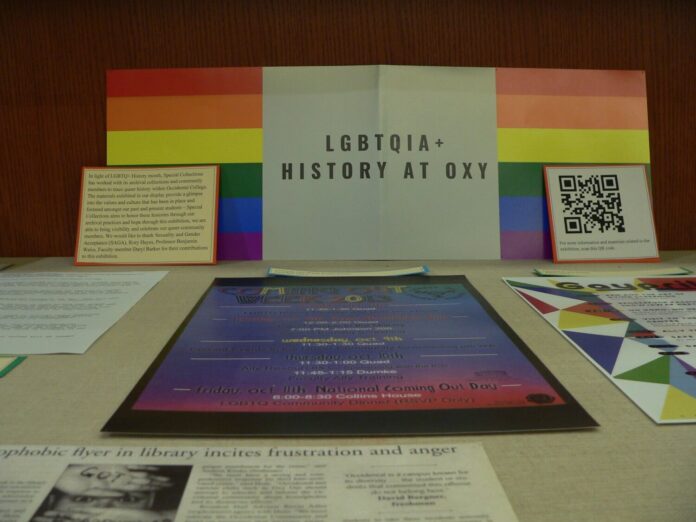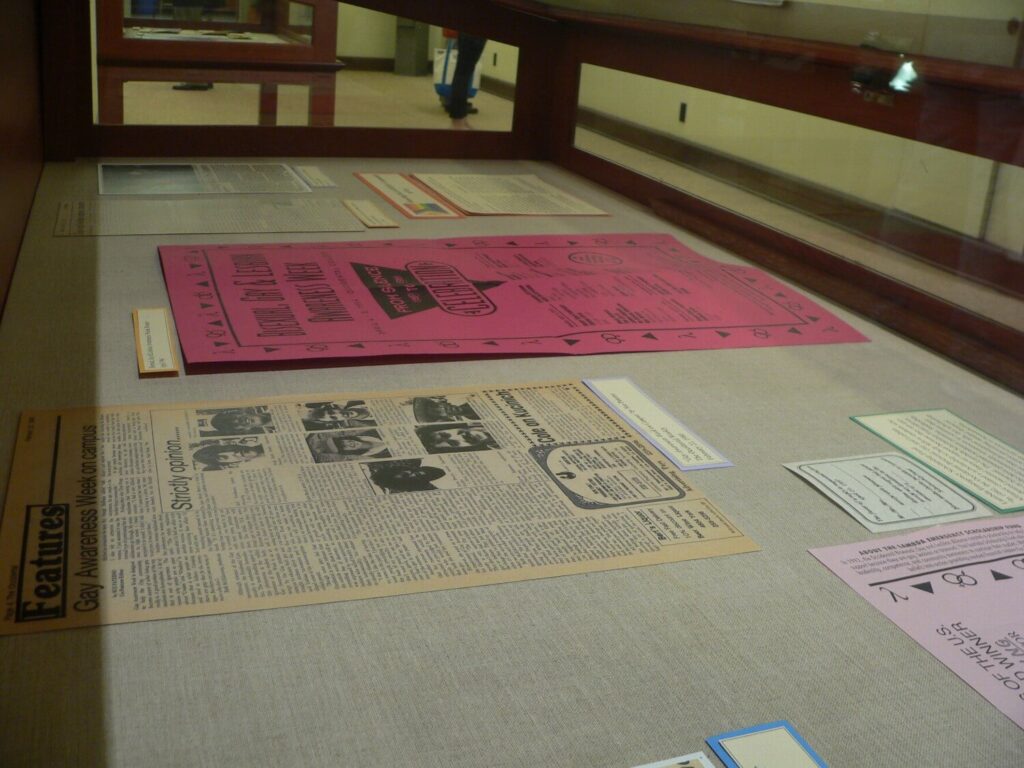
Celebrating LGBTQ+ History Month, Special Collections and College Archives has a spotlight exhibit called “Honoring the LGBTQIA+ Community at Oxy.” Talia Elfezouaty (sophomore) and Alex Kawawaki (senior) curated the exhibition; both are student workers at the Academic Commons. According to Julie Tanaka, director of Special Collections and College Archives, the exhibit will run through the end of October in the Academic Commons. The gallery is located by the Ahmanson Reading Room.
Elfezouaty said one goal of the exhibit is to showcase what is missing in the preservation and documentation of Occidental’s LGBTQ community.
“While Occidental does have a longer history than other colleges, there is a lot missing in our history, a lot that hasn’t been said, and a lot that hasn’t been done in regards to [uplifting] the LGBTQ+ community,” Elfezouaty said. “It’s really important that we bring awareness to missing [LGBTQ history] and move forward and be able to add things.”

Ben Weiss ’16 is a professor for Occidental’s sociology department and contributed to the exhibit. According to Weiss, Elfezouaty reached out to him knowing he could help guide her and Kawawaki’s research for the exhibition, especially since he was a student at Occidental when the college’s LGBTQ living spaces and communities were undergoing significant development.
Weiss said he helped found Queer House, now called Baldwin House. He said it was, and still is, important for LGBTQ identifying folks to have a space to comfortably and unapologetically explore themselves and their personal expressions such as fashion and visual arts. According to Weiss, the LGBTQ themed living community is a significant part of the Occidental LGBTQ community’s history.
“Lots of the experiences that largely straight folks are able to have on a college campus — learning about their sexual, romantic interests, building relationships, finding partners — lots of that stuff happens in spaces where queer folks may not always feel welcome,” Weiss said. “So living in a space that was only queer people allowed people space to explore new facets of their personalities, of their social lives.”
Elfezouaty said she is most drawn in by the photos of the members of Baldwin House and LGBTQ+ student organization gatherings from decades ago.
“It’s one thing to read about it, but to actually see things actually occurring was really important,” Elfezouaty said.
Elfezouaty said seeing photos around campus and associating them with locations she has visited or seen is significant because it helps her understand the remarkable effort and perseverance of earlier Occidental LGBTQ+ communities.
Kawawaki said there were many more materials that she and Elfezouaty wanted to include, like posters and archival documents such as event budgets and RSVP cards, but the college archives lacked these records. According to Kawawaki, they had to rely on reaching out to alumni and staff members for archives that were not documented in physical forms, like photographs. She said she and Elfezouaty compiled all the sources they used but could not include in their exhibit into a Google Document, and they hope to add more in the future.
Kawawaki said that another challenge she faced was whether or not to include articles from the student newspaper detailing homophobic or transphobic incidents — she was unsure if she should include them in an exhibit celebrating LGBTQ+ experiences.
In 1994, there was an incident in which four off-campus intruders crashed an Occidental party that was co-sponsored by the Bisexual, Gay and Lesbian Alliance and made homophobic comments and verbal threats. In 2016, a Haines Hall gender neutral bathroom sign was removed, and “men’s bathroom” was scribbled in Sharpie over the sign.
“We wanted to focus more on the traditions and culture that queer people actually have fostered here at Oxy, and not the atmospheres of intolerance by other people,” Kawawaki said.
Weiss said it is up to students and members of LGBTQ+ communities to decide what the exhibit means to them and what to take away from it. He said interpreting the exhibit’s significance is like being part of an LGBTQ+ community — everyone has their own way of experiencing it, and everyone finds different parts of it that help define their identity.
“People are always challenging, contesting, imagining, creating,” Weiss said. “I think it’s up for students to decide what it means to be queer and what a queer community is for.”
Kawawaki said she hopes this exhibit brings more visibility to Occidental’s LGBTQ+ communities and that, moving forward, the college archives are more adamant about preserving and documenting LGBTQ+ history that is specific to the college.
“There are some histories that shine more, and we need to highlight [LGBTQ+] communities,” Kawawaki said. “I think that it’s important to showcase that queer people are here, we’ve been here, and are still here.”
![]()


































